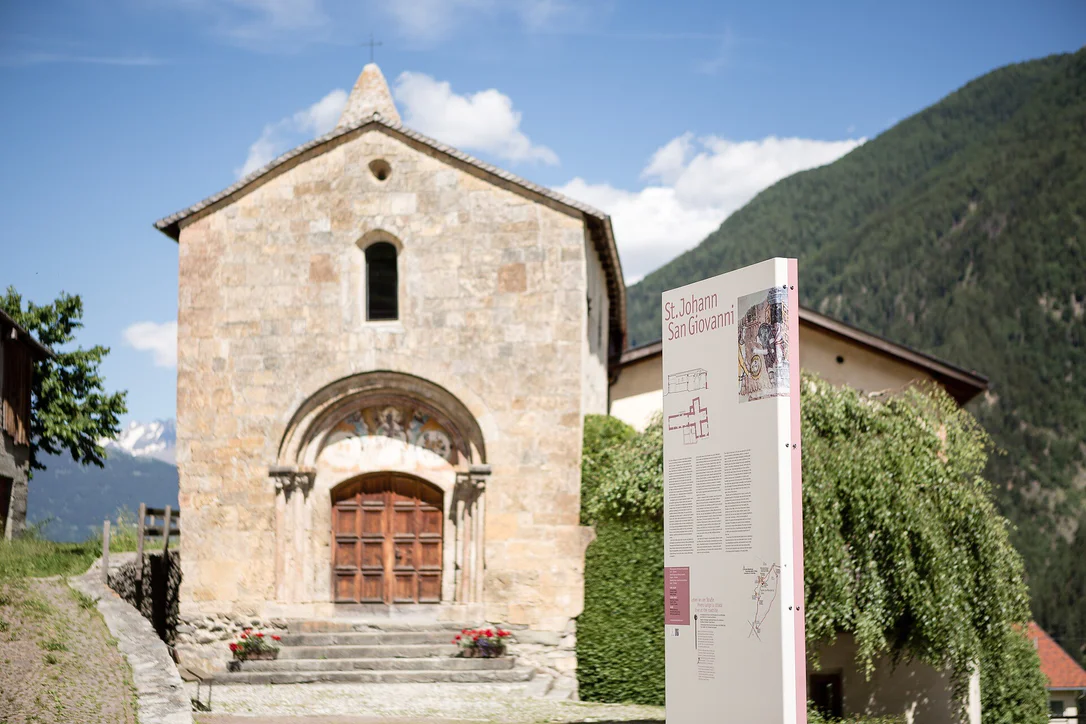Agums
Die 296 Einwohner zählende Ortschaft Agums (906 m ü.d.M.) liegt als ehemals eigenständige Dorfgemeinschaft, danach Fraktion, nunmehr inkorporierter Bestandteil der Marktgemeinde Prad am Stilfserjoch im Vinschgau, dem Westen Südtirols.
Der Name Agums soll laut E. Kühebacher, „Die Ortsnamen Südtirols und ihre Geschichte“, 1991, auf das rätorom. acúmnes, was so viel wie Sumpf bedeutet, zurück gehen.
Erstmals urkundlich belegt wird Agums, durch Rudolfi de Agunde, er bezeugte am 30. Juli 1209 das Urteil des Grafen Albert III. von Tirol im Streit der Kortscher mit dem Kloster Marienberg wegen eines Holzschlags im Montatschwald. Die zu jener Zeit unscheinbar kleine Siedlung am Schnittpunkt des bedeutsamen Saumweges nach „Wurms“ (Bormio), unterlag zum Großteil der Grundherrschaft der Bischöfe von Chur. Diese dürften mit einiger Sicherheit, wohl auf dem Ansitz Gargitz, ihren Verwaltungssitz (prepositura de Agundes) inne gehabt haben. Das heißt wiederum, dass die Propstei Agums, nicht nur Administrations- und Zinssammelstelle war, sondern auch Gerichtsort für die bischöflich-churischen Eigen- und Lehensnehmer, den so genannten Gotteshausleuten von Agums, Prad, Lichtenberg, Tschengls und Stilfs. Als dann der Churer Bischof Siegfried v. Gelnhausen, auf beständiges Bitten, Agums 1303 zum eigenständigen Pfarreisitz erkor, wurde die kleine Siedlung am Fuße des „Montoni“ (1.971m) auch zum kirchlichen Bezugspunkt der Gläubigen aus Prad, Stilfs, Trafoi und Sulden. Erst recht nach Vollendung des Kirchen-Neubaus (1493-1510) bzw. der Weihe am 9. Mai 1510 durch P. Stephanus zu Chur, gewann Agums vollends Beachtung. Die weitum sichtbar gewordene Gottesburg zum hl. Ritter und Märtyrer Georg mit ihrem mächtigen Turm zog vermehrt gläubige Verehrer und Pferdebesitzer zu ihrem Patron. Agums, Pfarrsitz des Bistums Chur (bis 1816, danach Bistum Brixen) beherbergte stets nicht nur den jeweiligen Pfarrherrn, sondern diente seiner Lage zufolg, den diversen Bürgern, Bauern und Lehenträgern als Wohnsitz. Ab 1705 ist Agums, dank des wundertätigen Kruzifixes, dann auch noch zum begehrten Wallfahrtsort geworden und bot dem zufolge neben einer Schenke auch einen Beherbergungsbetrieb. Nach dem Bau der neuen Kirche Maria Königin 1956/58 und dem damit einhergehenden Wechsel des Pfarreisitzes nach Prad, wurde nicht nur St. Georg ins Abseits versetzt, sondern auch Agums selbst verlor an Bedeutung. Die Situation hatte sich dahingehend verändert, dass die Kirchgänger von Prad, nach 650 Jahren nicht mehr nach Agums, sondern die Agumser nach Prad müssen. Jedoch setzte ab 1988, nach erfolgter Restaurierung der alten Pfarrkirche und weiterer dankenswerter Initiativen eine rege Wiederbelebung von Kirche und Dorf ein. So bietet Agums dem Besucher von heute, neben wertvollen historischen Ensembles, einen Gasthof, eine Bar und Beherbergungsmöglichkeiten in dörflich ruhiger Lage.
























































































